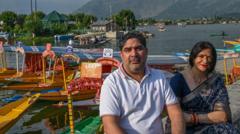More than 1.4 million Muslims have commenced this year's Hajj pilgrimage in Mecca, following a tragic incident last year that resulted in the loss of approximately 1,300 lives, largely due to the extreme heat. In a bid to enhance safety, Saudi authorities have introduced comprehensive guidelines and precautions aimed at mitigating the effects of the anticipated high temperatures, expected to peak at 44°C (111°F).
Authorities reported that they have significantly increased safety measures, including the planting of thousands of trees and the installation of hundreds of cooling systems throughout the vicinity. They've instituted a ban on children under the age of 12 from participating in the pilgrimage, while anyone attempting to enter Mecca without official authorization faces a hefty fine of $5,000 and a potential 10-year entry ban. As of Sunday, over 269,000 individuals were prevented from accessing the holy site.
Last year, a substantial number of the pilgrims who tragically lost their lives were found to be unregistered, lacking access to essential resources such as air-conditioned accommodations and adequate transportation. Many were either unable to afford the expensive official Hajj packages, which range from $4,000 to $20,000 depending on various factors, or chose to enter Saudi Arabia on tourist visas outside of the official Hajj arrangements.
The Hajj pilgrimage is a fundamental aspect of Islam, mandated for all able adult Muslims at least once in their lifetime. Pilgrims begin the rite clad in two white cloths, known as Ihram, while women wear modest clothing with their heads covered. Upon arrival at Mecca, they pay homage to Islam's holiest site, the Grand Mosque, by circling the Kaaba and performing additional rites.
To combat the risks associated with sweltering temperatures, the Saudi health ministry has urged all pilgrims to adhere to strict safety protocols. These include avoiding direct sunshine during peak hours, utilizing umbrellas for shading, and staying hydrated. Authorities have expanded shaded areas by a total of 50,000 square meters, established over 400 cooling units, and modified road surfaces to better handle the intense heat. Additionally, artificial intelligence will assist in drone monitoring and crowd management to ensure a safe pilgrimage experience.
Historical incidents have marred past Hajj observances, including the 2015 tragedy where over 2,300 people lost their lives in a stampede in Mina. As officials strive to implement measures that ensure the safety of pilgrims, the ongoing endeavor focuses on preventing similar calamities during this sacred journey.




















